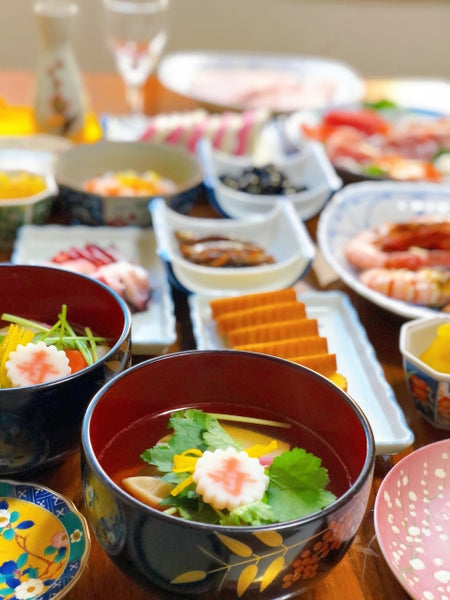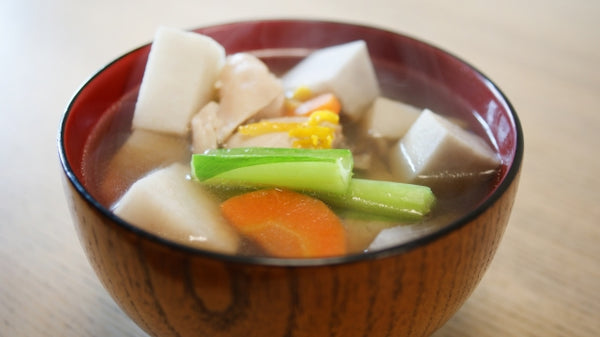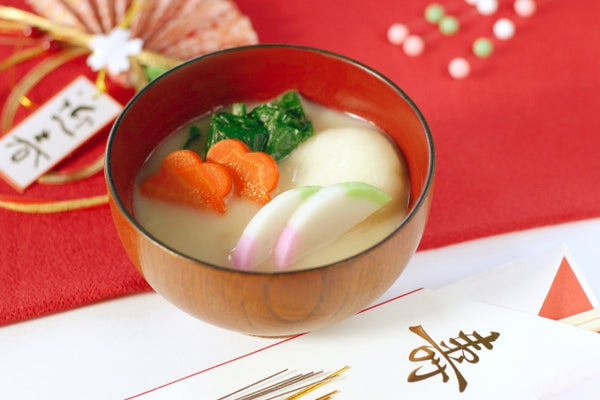Ozoni: Mochi Soup for Soup-er Luck in the New Year

Every culture has its own special foods prepared to usher in luck for the coming year. In the American South, black-eyed peas are a staple. In Spain, people eat grapes at the stroke of midnight. And in Japan, ozoni is a traditional dish eaten for breakfast on New Year’s Day. Ozoni is a type of mochi soup typically accompanied by vegetables, herbs, fishcakes, and chicken. However, each region of the country puts its own spin on the dish.

The most distinct differences in ozoni can be found between the recipes of the east and west of Japan. In the Kanto region (the eastern side of Japan), the broth of the soup is amber and light, with the flavor stemming from a base of bonito dashi and the simple but flavorful additions of soy sauce and sake. The star of the dish, the mochi, is rectangular and toasted before being added to the soup, giving it a crisp exterior and chewy interior. Another aspect of the Kanto style is komatsuna, a type of mustard green that is plentiful during the winter months. For a final touch, the soup is garnished with twists of yuzu peel for color and taste.

While the country's eastern side has a propensity for simplicity, the western side has leaned into indulgence. The ozoni broth there is supplemented with saikyo white miso, which lends a richer and somewhat sweet tang to the kombu (seaweed) based broth. Another distinction is the mochi, which is round and boiled separately, then added to the soup just before serving. Round mochi was the norm in Japan for about 400 years, as it was handmade. However, as people moved to larger cities and industrialization began, it became easier to make and cut rectangular mochi, thus leading to a divergence in styles. Root vegetables make up the bulk of the soup, with daikon, taro, and carrot being abundant despite the cold. And for an umami finish, bonito flakes that flutter in the heat before almost dissolving into the broth are a must.
As with many traditional foods on the New Year’s menu in Japan, there is symbolism to be found in the ingredients of ozoni. The chewy stretch of mochi symbolizes flexibility, longevity, and endurance. And in its circular form, it is also said to echo the ideas of peace and harmony in the new year. The kamaboko fish cakes, formed into two-tone slices, have dual meanings in their colors. White represents purity, while pink, an offshoot of red, is said to ward off evil and welcome luck. Finally, the chicken and greens symbolize honor and recognition, drawing from similarities in the sounds of the two phrases.
Ozoni is a dish that summons up strong memories for many Japanese. Not only is it a reminder of joyful New Year’s celebrations and time with family, but it also shows each household’s unique heritage and background. Marriages across regions bring about the merging of recipes, and moves from one part of the country to another lead to the adaptation of ingredients, making each family’s recipe as special as the members of the family themselves.
About the author:

Nadine Lindskog
Nadine first became interested in Japan and Japanese culture after working with an exchange program at her university. After hearing so many wonderful things from the exchange students she worked with she was longing for a chance to see Japan for herself. That opportunity came to her in the form of the JET program where she spent 5 years on a small island in the beautiful prefecture of Okinawa. While living in this very rural community of just under 1,300 people she was lucky to experience a glimpse into some of Okinawa’s unique traditions and culture. In her free time, she traveled the main island of Japan as well as eastern Asia, seeking out the most delicious foods and exciting experiences. She currently resides in the United States but hopes to return to Japan in the future.




